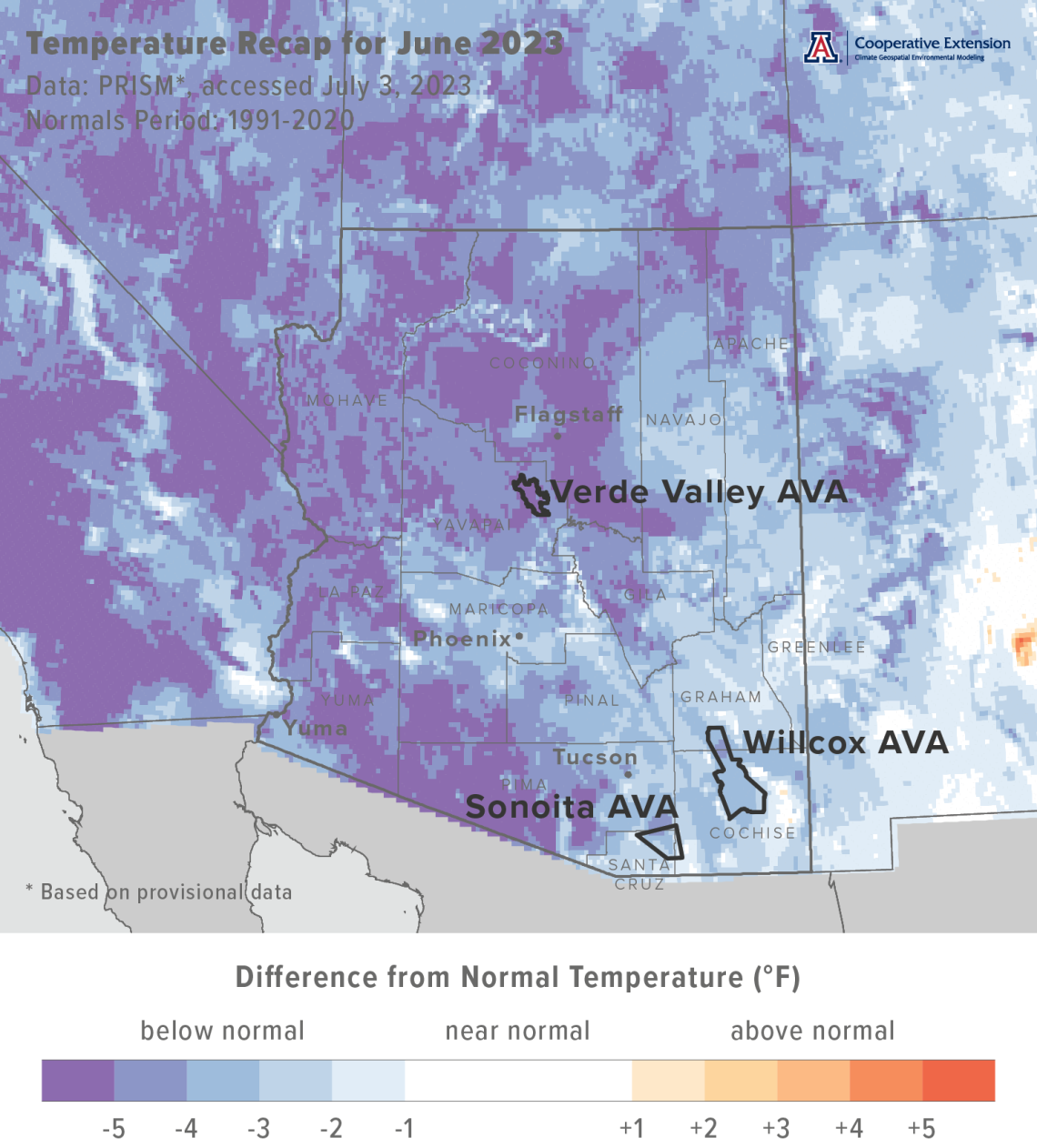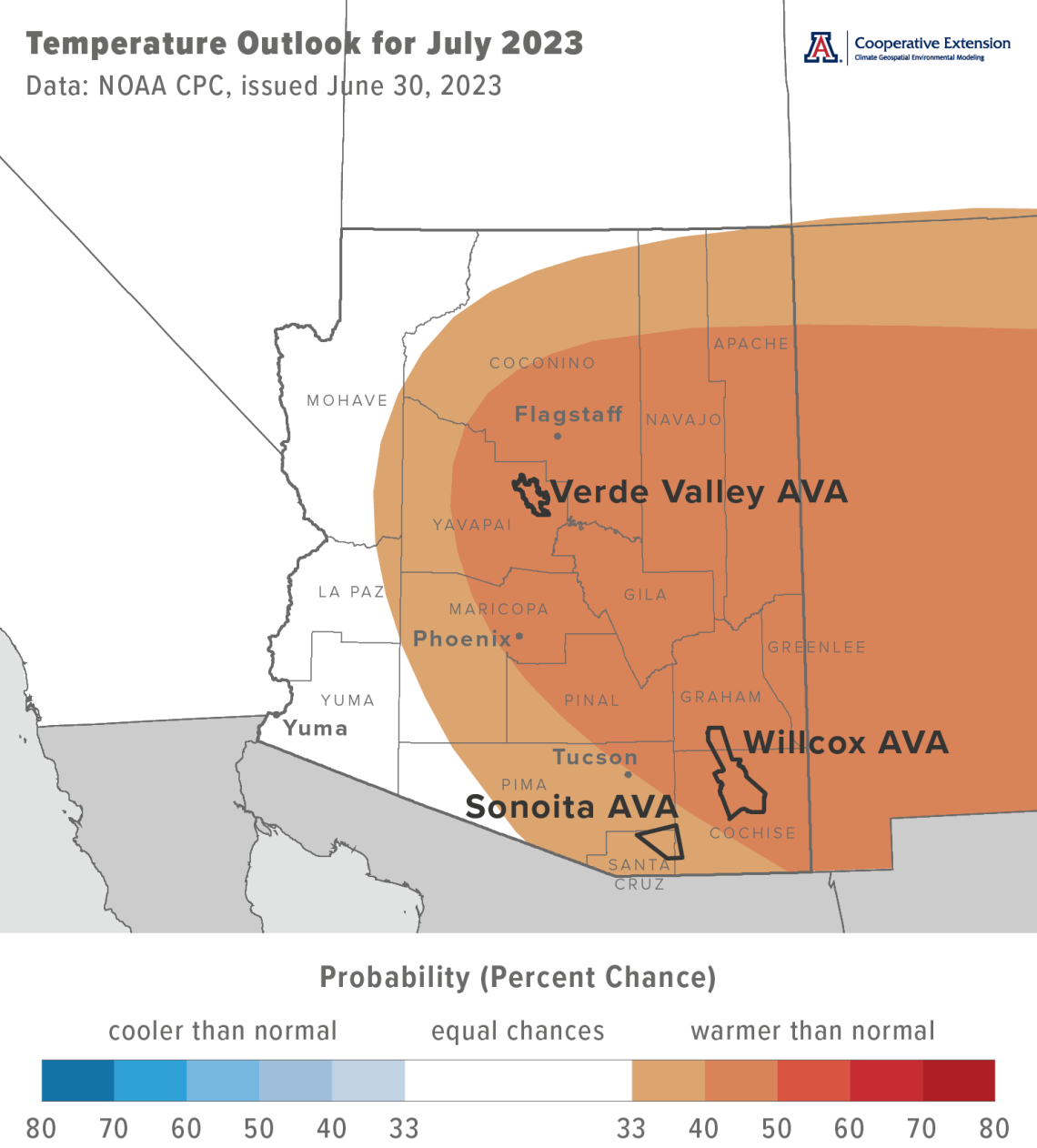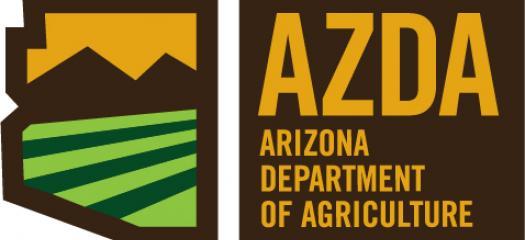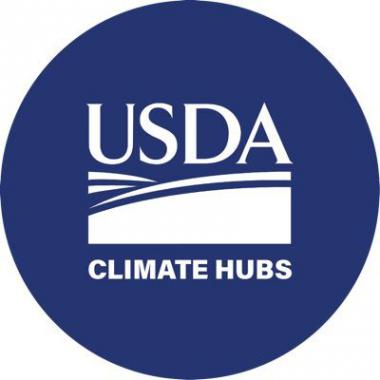Climate Viticulture Newsletter - 2023 July
< Back to Climate Viticulture Newsletter
Hello, everyone!
This is the July 2023 issue of the Climate Viticulture Newsletter – a quick look at some timely climate topics relevant to wine grape growing in Arizona.
June Recap | July Outlook | Growing Season Heat Accumulation | Extra Notes
A Recap of June Temperature and Precipitation
Monthly average temperatures were 1 to 4 °F below the 1991-2020 normal for much of the southeastern and east-central parts of Arizona (light blue, blue, and dark blue areas on map), including the Sonoita and Willcox AVAs. Much of the rest of the state, including the Verde Valley AVA, measured temperatures even further below normal (light purple and dark purple areas on map). For reference, monthly temperatures in June last year were up to 2 °F warmer than normal in parts of southeastern and north-central Arizona, including the three Arizona AVAs. Otherwise, temperatures were 2 to 4 °F above normal.
Area-average maximum and minimum temperatures during June 2023 were 88.6 and 55.2 °F for the Sonoita AVA, 89.7 and 53.8 °F for the Verde Valley AVA, and 91.5 and 55.1 °F for the Willcox AVA. Respective June normals are 90.6 and 59.0 °F, 95.4 and 58.4 °F, and 94.5 and 59.1 °F.
cvn-recap-202307-tmeanDepartureNormal.png

Monthly precipitation totals were less than 25 % of normal for the southern two-thirds of the state (dark yellow area on map), including all three Arizona AVAs. For the northern one-third, amounts mostly were between 25 and 125 % of normal (yellow, light yellow, and white areas on map). A relatively early start to the monsoon during June 2022 led to precipitation totals that were more than 200 % of normal for most of the state.
Area-average total precipitation in June 2023 was 0.00 inches for the Sonoita AVA, 0.00 inches for the Verde Valley AVA, and 0.00 inches for the Willcox AVA. Respective June normals are 0.55, 0.18, and 0.42 inches.
Based on the daily weather summaries for the AZMet Bonita and Willcox Bench stations in the Willcox AVA, total reference evapotranspiration values last month bring growing season totals to 22.7 and 24.4 inches, respectively. Total precipitation from April through June, in contrast, is 0.06 and 0.17 inches, respectively.
Dig into daily weather summaries from 2023 for the AZMet Bonita and Willcox Bench stations in the Willcox AVA
Learn more about PRISM climate data
cvn-recap-202307-pptPercentNormal.png

The Outlook for July Temperature and Precipitation
Temperatures over the course of this month have a slight increase in chances for being above the 1991-2020 normal across the eastern two-thirds of Arizona (light orange and orange areas on map). For the western third, there are equal chances for below-, near-, or above-normal temperatures (white area on map). Monthly temperatures in July last year were within 2 °F of normal for much of the state.
Area-average maximum and minimum temperatures during July 2022 were 88.8 and 62.9 °F for the Sonoita AVA, 99.3 and 69.3 °F for the Verde Valley AVA, and 94.1 and 66.2 °F for the Willcox AVA. Respective July normals are 88.5 and 62.8 °F, 98.1 and 66.0 °F, and 93.6 and 64.9 °F.
cvn-outlook-202307-temp.png

Precipitation totals for this month have a slight increase in chances for being below normal across almost all of the state (light tan and tan areas on map). Only the southwestern corner differs from this, with equal chances for below-, near-, or above-normal totals (white area on map). Precipitation during July 2022 was near or above normal for almost all of the state.
Area-average precipitation totals in July 2022 were 6.12 inches for the Sonoita AVA, 1.74 inches for the Verde Valley AVA, and 2.53 inches for the Willcox AVA. Respective July normals are 4.06, 1.75, and 2.67 inches.
The current hot-and-dry conditions due to a weak and sluggish monsoon onset look to continue in the coming days, and contrast with the relatively rainier conditions we saw at this point in the 2022 and 2021 growing seasons. Another possible difference with the past two years is a later start to the ripening and harvest season, which we look at next.
To stay informed of long-range temperature and precipitation possibilities beyond the coverage of a standard weather forecast, check in, too, with the six-to-ten-day outlook and eight-to-fourteen-day outlook issued daily by NOAA’s Climate Prediction Center.
cvn-outlook-202307-prcp.png

Heat Accumulation during the Growing Season
Heat accumulation from April through June this year for the AZMet Bonita and Willcox Bench stations (blue bars on graph) is less than what it was at this time last year. This suggests that vine growth rates and time between bud break and veraison growth stages may have been slower and longer so far this growing season than what they were in the previous one. Also, heat accumulation is greater at AZMet Willcox Bench than at AZMet Bonita, suggesting that a given variety in the south-central part of the Willcox AVA is at a more advanced growth stage than in the northern part, all else equal. Over the past seven years, the least amount of heat accumulation for both locations at this point in the growing season happened in 2019, a result of temperatures in May that year being 4 to 8 °F below normal across much of the state.
Like the last two months, we’re using the Wang-Engel model to calculate heat accumulation, one that accounts for the slowdown or stoppage of vine photosynthesis and growth as temperatures surpass 95 °F. Afternoon temperatures in the Willcox AVA during the latter part of last month were above this threshold for several days. The hottest maximum daily temperatures happened on June 26 for the AZMet Bonita and Willcox Bench stations, with values of 103 and 104 °F, respectively.
cvn-growing-season-heat-accumulation-202307.png

Extra Notes
Based in part on recent hot and dry conditions and a weak and sluggish onset of the monsoon, there is an above-normal potential this month for significant wildland fires across southeastern, central, and extreme northwestern Arizona. Elsewhere across the state, potential is near normal.
What was last month an impending El Niño event now is present and is likely to strengthen as we approach winter. We’ll keep an eye on this over the coming months.
For those of you in southeastern Arizona, including the Sonoita and Willcox AVAs, Cooperative Extension manages an email listserv in coordination with the Tucson forecast office of the National Weather Service to provide information in the days leading up to agriculturally important events, like heat waves and monsoon outbreaks. Please contact us if you'd like to sign up.
And for those of you in north-central and northeastern Arizona, including the Verde Valley AVA, Cooperative Extension also now manages an email listserv in coordination with the Flagstaff forecast office of the National Weather Service to provide similar information for this part of the state. Please contact us if you'd like to sign up.
Undergraduate students in the College of Agriculture and Life Sciences at the University of Arizona are looking for internships with businesses and companies in the viticulture and winery industries. Please contact Danielle Buhrow, Senior Academic Advisor and Graduate Program Coordinator in the Department of Agricultural and Resource Economics, for more information.
Please feel free to give us feedback on this issue of the Climate Viticulture Newsletter, suggestions on what to include more or less often, and ideas for new topics.
Did someone forward you this newsletter? Please contact us to subscribe.
Have a wonderful July!
With current and past support from:






